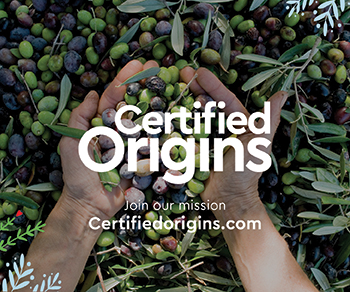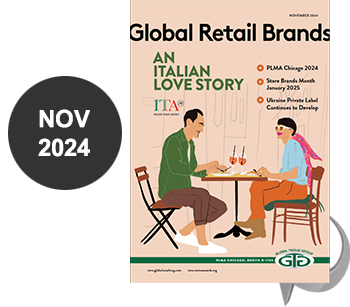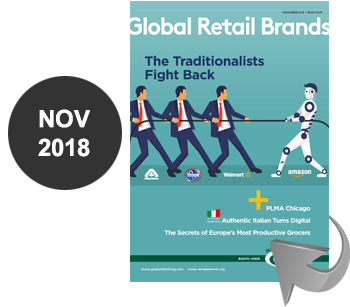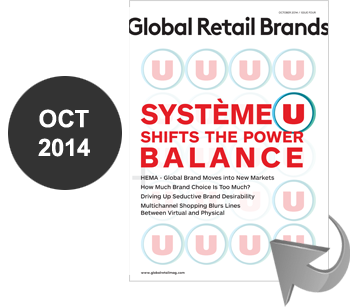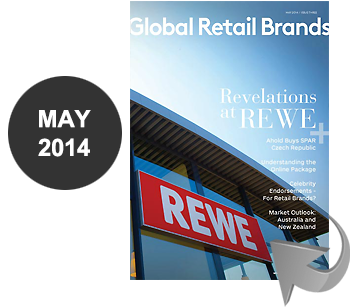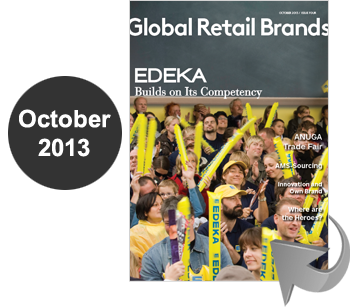By Christina Veiders

Through the lens of education, the ITA is redefining Italian food and products for major retailers across the US.
The Italian Trade Agency forges ahead with its authentic Italian campaign by informing supply-side retail management through education/culinary training taught by chefs from Italy.
The ITA – Chicago, a government organization established to increase the internationalization of Italian companies, began partnering with US supermarket and mass retailer chains in 2015 to promote authentic Italian products.
Retailers such as H-E-B, Wakefern Food Corp. (ShopRite), Meijer, Price Chopper, Mariano’s, Hy-Vee, Walmart Stores Inc., Sam’s Club, Rouses Markets, and Schnucks launched their own Italian-themed promotions in support of the ITA’s multi-million-dollar promotional and marketing campaign.
These alliances resulted in co-sponsored in-store promotion and digital marketing programs that featured special displays of authentic Italian items with tastings, cooking demos and consumer educational materials on Italian regional foods, recipes and cooking techniques.
In addition to increasing retail sales of authentic Italian products, the success of the ITA’s joint marketing programs also contributed to the development and launch of Walmart’s “Sam’s Choice Italia” and Hy- Vee’s “Gustare Vita” authentic Italian private label lines.
This year’s offering of the Educational & Culinary Training Program, uniquely designed for American supermarkets and mass retailers, is one of the ITA’s most ambitious programs to date.

MARCO SALADINI, Trade Commissioner – Chicago, says the goals of the program are to educate major retail decision-makers such as buyers, store managers and corporate chefs on Italian food traditions and expand their knowledge of authentic Italian cuisine and ingredients. “We are providing these industry professionals with a better understanding of product quality and validity that will assist them in making informed purchasing, merchandising and menu development decisions as they relate to authentic Italian,” he explains.
The main goal of every masterclass, is to allow attendees to walk away with a better understanding of what Italian cuisine really is ollaborating with ALMA, the International School of Italian Cuisine in Colorno, Italy, the ITA developed a series of training sessions specifically tailored to each retailers’ participants. Lesson plans were not only customized to the desired culinary focus of each retailer, but also to participants’ specific roles in an effort to educate everyone on how to apply their new-found knowledge directly to their day-to-day responsibilities.
“When designing each masterclass, we initiated a conversation with the key players involved and made sure to tailor each class to their specific needs,” says Carlo-Maria Ricci, ALMA chef. He notes that ALMA has an organic and diverse staff with specific areas of expertise that contributed to meeting each retailer’s requirements.
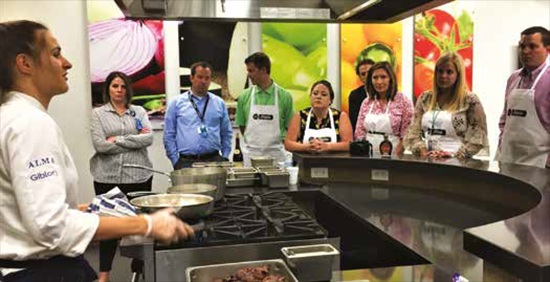
“The main goal of every masterclass,” says Ricci, “is to allow attendees to walk away with a better understanding of what Italian cuisine really is. This means providing as many practical and theoretical tools as possible to allow them to recognize, understand and implement the fundamentals at the base of traditional Italian cuisine.”
The ITA points to the growing demand and interest in Italian gastonomy by citing a 2019 YouGov survey in which over 25,000 people in 24 countries identified Italian as the most popular cuisine. As consumers become more aware, it’s essential for retailers to keep up with the momentum and provide solutions that are both relevant and true to what Italian cuisine really is. To allow this to happen, the ITA had to show retailers what and how Italians really eat.
Trainings consisted of three days of interactive culinary lessons and presentations on authentic Italian cuisine and techniques. Each Custom programs ranged from three single-day trainings for different professional audiences to one, three-day culinary intensive training for select individuals.
This Spring, the ITA launched the Educational & Culinary Training Program by piloting five training sessions with Walmart, Rouses Markets, H-E-B, and Wakefern (ShopRite). With over 100 hours of training, the program reached two hundred retail buyers, store managers, chefs, associates and executives.
Prior to training, participants were surveyed about their objectives and expectations.
About 75 percent of participants had never before taken part in a similar type or event.
- The majority of participants felt that they did not have useful information to improve sell-in and/or sell-out of authentic Italian products.
- Many participants were not aware of Italian products, ingredients and techniques that they could implement in their jobs.
- When it came to using authentic Italian products as key ingredients in recipes, many indicated this was an area they knew little about.
- Many remained in the middle of strongly disagreeing or strongly agreeing whether or not they understood the inherent value of authentic Italian product versus Italian-sounding products.
During the training, participants received formal lectures and hands-on cooking lessons in authentic Italian cuisine and traditions.
Typical lesson concentrations included: understanding authentic Italian cuisine, product regionality, authenticity certifications and deep dives into Italian product categories.
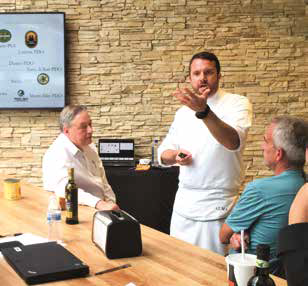
Classroom Lessons
The formal lectures and presentations primarily focused on defining authentic Italian, introducing regional cuisines and products and understanding Italian quality and authenticity certifications.
Authentic Italian products are defined as home grown, produced in Italy, often with certification seals or “Made in Italy” labels.
According to ITA’s training curriculum, cuisine with Italian-sounding names is: “A dish that boasts a name that somewhat recalls a typical Italian preparation but has been modified in various ways.”
Imitation Italian products use labeling with words, symbols or images recalling Italy and the Italian realm. Use of visuals, graphics and language that convey the sense of Italian often fool consumers into thinking they are buying authentic Italian products.
The results are big revenue losses, valued at $31 billion in the US and at $57 billion worldwide, for Italy’s agri-food industry due to the sale of Italian-sounding and fake products, according to Federalimentari.
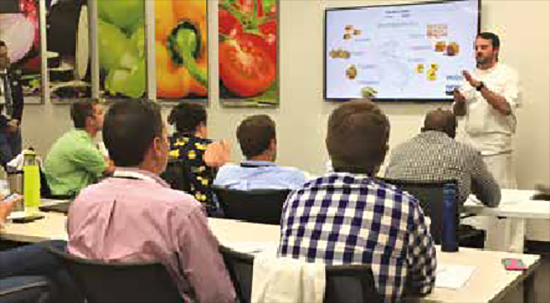
Culinary Training
In between the lectures, participants received hands-on culinary lessons in recipes, techniques and food traditions originating from different Italian regions.
Educational Tastings
Participants were immersed into a world of flavors and mouth-watering sensations as chefs guided them through proper tastings, pairings and other techniques to maximize flavor and overall eating experience. Participants sampled cheeses, wines, balsamic vinegar and pasta varieties to learn what differentiates Italian products from “Italian-sounding” products and how each region and process variation changes flavor profiles and product characteristics.
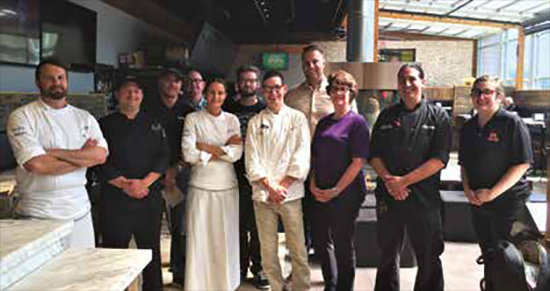
Some Perspective From an Italian Chef
Chef Ricci sees authentic Italian food “as the interaction of numerous traditional regional cuisines that, from a cultural point, have developed somewhat independently from each other.
“Italy is blessed with a diverse and quickly changing landscape, which results in a number of small microclimatic areas suited to different types and styles of agri-food productions.”
As an example, Ricci points to traditional Tuscan cuisine, which has become what it is thanks to the products and recipes that over time, have spanned from its unique geographical composition.
The same has occurred for every other Italian region.
“If we were to compare two distinct regions, like Tuscany and Veneto, we’d be able to identify very diverse cuisines and food cultures, based on different ingredients and boasting very different recipes.”
The commonality of these cuisines is simplicity, elegance and a respect for ingredients, notes Ricci.
“Pragmatically, this translates into recipes with generally fairly short ingredients lists and dishes that are, from the consumer’s point of view, easy to read and approach,” he says.
Cooking Demonstrations
Before entering the kitchen, participants were treated to instructive demonstrations where ALMA’s team of chefs walked the class through preparation and execution of an authentic recipe all while teaching the importance of technique, ingredients and origin of the dish.
Hands-On Learning
Once the demonstration was completed, participants put on their aprons to try their hand at cooking authentic Italian dishes. Participants, guided by a chef, combined their knowledge of flavors and regionality with newly learned cooking techniques. They learned how to make traditional favorites such as focaccia flatbread, risotto, tiramisù and lasagna in its authentic preparation, utilizing products from the region.
After the training, participants were surveyed on their overall training experience
- Nearly all participants strongly agreed they understood the inherent value of authentic Italian products versus imitations.
- All participants found the training sessions useful and could find various ways to incorporate the learnings into their jobs.
- Participants felt the knowledge learned from their training sessions will enhance their retailer’s values of respecting and serving customers better, striving for excellence in procurement and acting with integrity.
Going Beyond Sales
Marc Ardoin, corporate chef at Rouses Markets, Thibodaux, La., says the training will change their approach to merchandising. “The knowledge that [ITA] gave our store directors is going to help them build better displays in our stores that will help promote Italian products while educating our customers.”
Kim Levitsky, Walmart’s senior buyer for pasta, pasta sauce and soup, Bentonville, Ark., notes that customers want transparency in their food purchases and the training will help Walmart deliver on that.
“Authenticity is important … Not only what the ingredients are but also just the journey and history of the product.”
Participants said the education will help to build trust between their retailer and customers.
Natalia Kubantserva, Walmart’s manager for sourcing of private brands in dry grocery, hot beverages, breakfast and bread, says, “the results of the education and sourcing efforts will be that customers can trust Walmart products sold in stores. This will help customers understand that we aren’t just launching Italian product, but we are really trying to work with Italian manufacturers, growers and agents”.
Speaking the Same Language
The knowledge gained from the training program will facilitate supplier relationships. “As we build out flavors or co-create products together, we can speak with one single language. I am able to now apply information [learned] so that I’m not telling them [suppliers] to make something that isn’t authentic to their regions or to their cuisines,” says Walmart’s Levitsky.
Mark Emery, senior manager chef, product development for brands at Walmart, says, “Education sparked teamwork and inspiration for creativity.”He hopes to implement steps and easy pasta preparation methods that he learned to expand menu items in the hot case at the deli.
Participants also said they were eager to share their learnings with their colleagues to inspire new offerings.
Amy Zarichnak, kitchen manager at Wakefern Food Corp., Keasbey, NJ, was excited to take what she has learned back to her team. “We’re very often short on time and we’re also short on creativity so learning the things I’ve learned about inexpensive ingredients and techniques to extract the most flavors will be a huge boost to our hot bar.”
Positive Results of Training

The ITA believes that the pilot culinary education program exceeded goals. “Although the program’s goal is to educate the supply side of retail, its ripple effects can go much farther than our participants and their colleagues,” says ITA’s Saladini.
This will contribute to changing the scope of Italian products carried in store and expand the variety of product options for consumers, he believes.
“By educating store managers on ingredients and culinary traditions, they can improve the way they merchandise store products and boost product awareness, which could lead to better consumer recognition.”
Adding the Educational & Culinary Program, the ITA has developed a strong arsenal of joint offerings and a solid foundation for the growth of authentic Italian foods. In 2020, ITA will focus on enhancing its current offerings to maximize success and to better serve its partners with innovative programs tailored to their specific objectives.

